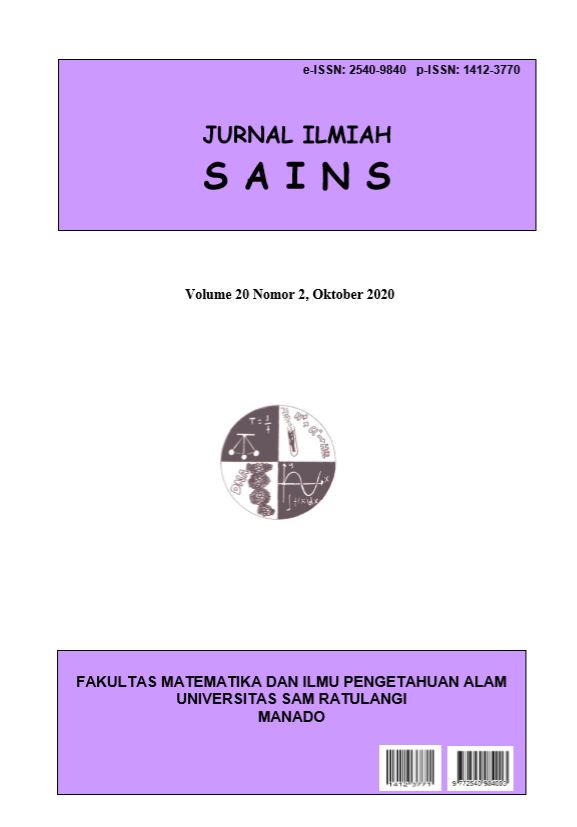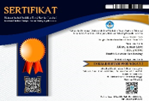Study on COVID-19 in the World and Indonesia Using Regression Model of SVM, Bayesian Ridge and Gaussian
DOI:
https://doi.org/10.35799/jis.20.2.2020.28256Abstract
In this article, research on data of total cases COVID-19 in the world and Indonesia is presented. The purposes of this research is to predict the number of cases COVID-19 mainly in Indonesia in the near future. The used methods are regression of Support Vector Machine (SVM) and Bayessian Ridge predicting 10 days forward in several countries where Bayessian Ridge gives better result. Similarly, both methods are employed to study the total cases COVID-19 in Indonesia. To include social distancing in the study, an exponential model is applied for initialization and then Gaussian is used to predict future total cases. Using Gaussian model, one has 2 scenarios of future predictions. The number of total cases on 24th April 2020 is 14675 and considerable not realistic. This is  updated i.e. the total number of cases in 24 April 2020 is 4242. Actually, the number of total positive cases COVID-19 on 24th April 2020 was 8211. Compared to the prediction with the real data, the approach of this research should be improved to give better prediction.
Keywords: Â Bayesian Ridge; COVID-19; Gaussian; Social distancing; SVM (Support Vector Machine)
Menelusuri COVID-19 di Dunia dan di Indonesia dengan Model Regresi SVM, Bayesian dan Gaussian
ABSTRAKPada artikel ini ditunjukkan penelusuran data total kasus COVID-19 di dunia dan di Indonesia. Penelitian ini bertujuan memprediksi banyaknya kasus COVID-19 terutama di Indonesia pada waktu tertentu mendatang. Metode yang digunakan adalah metode SVM (Support Vector Machine) dan regresi Bayesian Ridge dimana kedua metode berhasil memprediksi untuk total kasus COVID-19 di beberapa negara di dunia dan hasil Bayesian Ridge lebih baik. Untuk itulah kedua metode ini digunakan untuk menelusuri data total kasus COVID-19 di Indonesia. Akan tetapi pengaruh social distancing belum ditunjukkan sehingga digunakan model eksponensial dan Gaussian. Model eksponensial digunakan sebagai nilai awal untuk prediksi pada model Gaussian. Pada model Gaussian diperoleh prediksi dalam bentuk 2 skenario yaitu skenario terburuk dan skenario realistis. Skenario terburuk memberikan total kasus pada 24 April 2020 sebanyak 14675. Hal ini tidak realistis karena data terakhir pada 31 Maret 2020 sebesar 1677. Oleh karena itu diusulkan skenario realistis dimana total kasus puncak berlaku pada 24 April 2020 dengan total kasus 4242. Akan tetapi ternyata data total kasus positif COVID-19 pada 24 April 2020 sebanyak 8211. Dengan memperhatikan hasil prediksi dan yang diperoleh dari data, pendekatan yang sudah dilakukan masih memerlukan perbaikan.
Kata Kunci: Â Bayesian Ridge; COVID-19; Gaussian; Social distancing; SVM (Support Vector Machine)
References
Adi, P. (n.d.). Peneliti ITB Buat Pemodelan Prediksi Puncak Penyebaran COVID-19 di Indonesia. https://www.itb.ac.id/news/read/57444/home/peneliti-itb-buat-pemodelan-prediksi-puncak-penyebaran-covid-19-di-indonesia.
Ardila, S. (n.d.). Bappenas, UI modeling shows grim projection of COVID-19 spread in Indonesia. https://www.thejakartapost.com/news/2020/03/31/bappenas-ui-modeling-shows-grim-projection-of-covid-19-spread-in-indonesia.html.
Demidova, L., E. Nikulchev & Y. Sokolova. 2016. Big Data Classification Using the SVM Classifiers with the Modified Particle Swarm Optimization and the SVM Ensembles. International Journal of Advanced Computer Science and Applications, 7(5): 294–312. https://doi.org/10.14569/ijacsa.2016.070541.
Hamid, A.R.A.H. 2020. Social responsibility of medical journal: a concern for COVID-19 pandemic. Medical Journal of Indonesia, 29(1):1–3. https://doi.org/ 10.13181/mji.ed.204629.
Kowalczyk, A. 2017. Support Vector Machines Succintctly. www.syncfusion.com.
Lamidi, A. 2018. No Title. https://towardsdatascience.com/breast-cancer-classification-using-support-vector-machine-svm-a510907d4878.
Mckinney, W. 2018. Python for Data Analysis, 2nd edition. O Reilly Media, Inc.
Min-Wei, H., C. Chih-Wen, L. Wei-Chao, K. Shih-Wen & T. Chih-Fong. 2018. SVM and SVM Ensembles in Breast Cancer Prediction. Plos One, 12. https://doi.org/ 10.1371/journal.pone.0161501.
Ortiz-Ospina, M.R.H.R.E. 2020. Coronavirus Disease (COVID-19)–Statistics and Research. https://ourworldindata.org/ coronavirus.
Pambuccian, S.E. 2020. The COVID-19 pandemic: Implications for the cytology laboratory. Journal of the American Society of Cytopathology. https://doi.org /https://doi.org/10.1016/j.jasc.2020.03.001.
Permai, S.D. & H. Tanty. 2018. Linear regression model using bayesian approach for energy performance of residential building. Procedia Computer Science, 135: 671–677. https://doi.org/ 10.1016/j.procs.2018.08.219.
Prem, K., Y. Liu, T. Russell, A.J. Kucharski, R.M. Eggo, N. Davies, C. Group, for the M.M. of I.D.C.-19 W., M. Jit & P. Klepac. 2020. The effect of control strategies that reduce social mixing on outcomes of the COVID-19 epidemic in Wuhan, China. MedRxiv, 2667(20): 2020.03.09.20033050. https://doi.org/ 10.1101/2020.03.09.20033050.
Qian, H. 2018. Big data Bayesian linear regression and variable selection by normal-inverse-gamma summation. Bayesian Analysis, 13(4): 1007–1031. https://doi.org/10.1214/17-BA1083.







